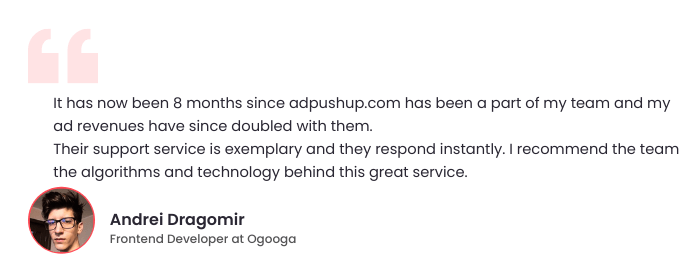If you’ve ever published content online (as a publisher, marketer or blogger), you would be familiar with the anticipation you feel once a post has been published, waiting for all the likes, tweets, comments and backlinks to come rolling in.
And if you’ve been doing this for a while, you would also be familiar with the feeling of disappointment that follows when your content turns out to be a total dud — it’s like screaming into vacuum with all your strength hoping for a shout back — but your voice just isn’t reaching through to anyone.
Why does this happen? There are many reasons for it. You produced great content but failed to market it well. Or alternatively, your marketing is great, but the content itself isn’t up to the mark. Of course, there are more contemporary problems beyond your control such as “content fatigue”—a user response to the overload of content the internet has experienced as more and more brands join the content marketing bandwagon — ever-increasing volumes of content directly translates to a decline in interest from users, as each piece of content has to now fight harder for attention.
What can be done? Vilfredo Pareto was an Italian economist who observed that 20% of the pea pods in this garden contained 80% of the peas. Later, in 1906, he observed that 80% of the land in Italy was owned by 20% of the population. This is now generally known as the Pareto principle or the 80/20 rule. In general terms, it states that:
“…for many events, roughly 80% of the effects come from 20% of the causes.”
This means that 80% of your sales come from 20% of your clients, 80% of accidents are caused by 20% of the motorists, 80% of beer is consumed by 20% of beer drinkers, and by analogy, 80% of the most viewed/shared content on the web comes from 20% of the content producers.
This is important, what are these 20% content producers doing that you’re not? Through this article, I aim to identify the factors that are holding back your content from reaching a wider audience, the strategies that may help you improve the chances of increasing its reach and the tools that you’ll need to get this done.
1. Don’t forget the basics
Before I delve deeper into the more specific things you can do to amplify the reach of your content, let’s first have a look at the more basic, hygiene issues. Some of these you may already know about, other maybe not, but they’re all equally important.
- Add share buttons — Just adding this one element helps your content receive up to 7 times more mentions, according to a report by BrightEdge Technologies.
- Target a niche — Unless you’re a hobbyist, you can’t afford to blog about motorcycles one day and baking on another day. Pick one and stick to it. It’s the only way to find and build an audience without confusing them.
- Craft better headlines — This is the first thing that a reader will come across before they read the rest of the content. A dull headline will fail your content every time. Experiment with interesting formats such as how to articles, list articles, what articles, why articles and figure out what works better.
- Improve your SEO — A good part of your traffic will come from search engines such as Google and Bing, which is if you spend a little time optimizing your content for them. Here’s a simple guide to SEO by Kissmetrics if you plan to do it manually. Or if you’re using WordPress, you can use a plugin to do it automatically.
- Use a post image and a featured image — Having a featured image improves the chances of a post being shared on Facebook, Twitter, and other social networks. Having at least one image inside the post (preferably at the top) serves as a visual anchor and increases reader interest.
- Have an author box or include a byline — Including a short bio lends credibility to the content and assigns a face to it, eliciting higher reader feedback.
- Re-purpose old content — A good amount of effort goes into creating high-quality content, so don’t share it on social networks only once after you’ve published it. Share it multiple times over a longer period so increase its visibility.
- Use data to improvise — Set up a Google Analytics account and keep a track of how your content performed based on vital metrics such as number of clicks, bounce rate and time on page to measure the success of your content, and gain a better understanding of what works.
- Share at the right time — Social media sharing service Buffer posted a very interesting story about sharing content at certain time on certain days led to higher engagement and response from the followers. Use this data to create your sharing strategy and even automate a schedule.
2. Establish your credibility
Even in the real world, we find it easier to trust people and organizations that have a certain level of credibility in our eyes; this effect is only amplified when it comes to the internet. You could come across the greatest piece of content ever produced, but you wouldn’t be inclined to share it if it happens to be posted on some random, author-less, badly designed blog filled with intrusive pop-up advertisements.
This is just human nature; we make snap judgments about the value of things based on their appearance, and then we treat it as such. In a series of research conducted by Stanford University over a period of three years, 10 factors were identified, the presence or absence of which determined the level of credibility a website commands. Here’s the takeaway:
- Make it easy for users to contact you.
- Make sure that the website is easy to use and navigate.
- Avoid errors like typos and broken links.
- Avoid using pop-up advertising.
- Update your website on a frequent basis.
- Design your website in a way that conveys professionalism.
- Set up a team page and have author boxes for posts.
- Provide your physical address and photo of the offices.
- Highlight the expertise in your organization.
- Provide links, citations and research sources.
3. Use the chunking method
According to a Nielsen report, on the average web page, readers only read about 20% of the content. This is because we don’t really read anymore — we scan words and sentences at random in order to save time. There is no getting around this. You can’t change the reading habits of the 2 billion people who use the internet, but you can make it easier for them to find the information they’re looking for. Information is only useful when you can find it with the least amount of effort. And obviously people tend to share things they find useful.
Chunking is a method of presenting information which splits concepts into small pieces or “chunks” of information to make reading and understanding faster and easier.
Think short everything. Shorter subheadings, shorter sentences, and shorter paragraphs reduce the cognitive effort that goes into processing information. Use bullet lists and highlighted text to guide your reader’s attention to the places where you need it to be.

4. Exploit the art of viral
Having your content go viral is like hitting an online lottery. But unlike a lottery which is totally random, content that goes viral does seem to follow a certain pattern.
The website Upworthy presents a good case for how content can be taken and repackaged in a way to increase the chances of it going viral. They find interesting but undiscovered videos and republish them with headlines that are so interesting (e.g. “A Boy Said She Was Too Ugly To Touch. She Believed It For 10 Years. Here’s What She Has To Say Now”) that they literally force a user to click and watch the video. They basically make content go viral simply by writing better headlines.
In a research titled “What Makes Content Go Viral?”, two University of Pennsylvania professors used a unique data set of all the articles published over a three month period to discover the factors that contribute to higher sharing of content. Here are a few findings from the survey:
- Longer articles gets shared more compared to shorter ones
- Practically useful, surprising, and interesting articles get shared more
- Articles that inspires anger, awe or anxiety gets shared more
So make sure that your content involves at least one or more of these elements so that it has the basic components in place that encourage a higher instance of sharing among users.
5. Optimize for mobile
Around 10 years ago, you used your phone for making and receiving calls, texting, and maybe playing a few games… then things changed as phones got faster processors, better screens and improved wireless technologies, allowing us to take the web with us wherever we went.
Last year, Comscore reported that mobile platforms — smartphones and tablets — combined account for 60% of total digital media time spent, up from 50% a year ago. This essentially means that mobile is the new PC.
How many times has it happened with you that you clicked on a link on your mobile that led to a website that either (1) took ages to load, (2) required to you to pan, scroll and resize endlessly to view the content, (3) kept throwing up annoying pop-ups and dialogue boxes — until you finally had to close the page out of frustration? One thing you can do to ensure this doesn’t happen to your users is to implement a responsive design for your website.
Responsive web design is an approach to web design that focuses on providing an optimal viewing experience — easy reading and navigation with a minimum of resizing, panning, and scrolling — across devices of all shapes and sizes, from computers to mobile phones.
If your website is based on popular content management systems such as WordPress, Joomla and Magento — you will find hundreds of beautifully designed out-of-the-box responsive themes. Or you can have a designer create one according to your specifications, even though the latter would be more expensive.
6. Know the mover and shakers
The world may have moved online, but the rules of engagement are still the same. Knowing the right people in the right places — i.e. connection capital — pays.
Religiously follow key players in your industry category (start small, don’t email Seth Godin just yet) and interact with them, it’s really never been easier. Leave a constructive feedback on their blog; write them an email introducing yourself and what you do, say that you admire their work, reply to their tweets — most people will not mind this kind of friendly communication.
From there, you could send them something you wrote and ask them a brief feedback on it, or request them to share it on their social networks, and obviously, return the favour without asking. Doing this will not only get new eyeballs for your content but also help build a valuable professional network that you could reach out for advice.
Image via Vincent Diamante

Shubham is a digital marketer with rich experience working in the advertisement technology industry. He has vast experience in the programmatic industry, driving business strategy and scaling functions including but not limited to growth and marketing, Operations, process optimization, and Sales.





